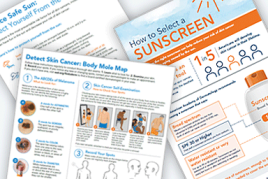Injured skin
If you have a minor skin injury or bug bite, how you treat it can affect healing. These dermatologists’ tips tell you what you need to do.
 Atopic dermatitis: More FDA-approved treatments
Atopic dermatitis: More FDA-approved treatments
Research breakthroughs are giving patients with atopic dermatitis/eczema more ways to treat this condition. See what a treatment plan may include.
 Biosimilars: 14 FAQs
Biosimilars: 14 FAQs
Find answers to questions patients ask about this newer treatment option, including, “What’s involved in switching from a biologic to a biosimilar?”
 How to trim your nails
How to trim your nails
Keep your nails looking their best with these tips from board-certified dermatologists.
 Relieve uncontrollably itchy skin
Relieve uncontrollably itchy skin
Find out what may be causing the itch and what can bring relief.
 Fade dark spots
Fade dark spots
Find out why dark spots appear and what can fade them.
 Untreatable razor bumps or acne?
Untreatable razor bumps or acne?
If you have what feels like razor bumps or acne on the back of your neck or scalp, you may have acne keloidalis nuchae. Find out what can help.
 Tattoo removal
Tattoo removal
Find out why laser tattoo removal outshines other methods for removing a tattoo.
 Scar treatment
Scar treatment
If you want to diminish a noticeable scar, know these 10 things before having laser treatment.
 Free materials to help raise skin cancer awareness
Free materials to help raise skin cancer awareness
Use these professionally produced infographics and videos to help others find and prevent skin cancer.
 Dermatologist-approved lesson plans, activities you can use
Dermatologist-approved lesson plans, activities you can use
Free to everyone, these materials teach young people about common skin conditions, which can prevent misunderstanding and bullying.
 Find a Dermatologist
Find a Dermatologist
You can search by location, condition, and procedure to find the dermatologist that’s right for you.
 What is a dermatologist?
What is a dermatologist?
A dermatologist is a medical doctor who specializes in treating the skin, hair, and nails. Dermatologists care for people of all ages.
If you have a minor skin injury or bug bite, how you treat it can affect healing. These dermatologists’ tips tell you what you need to do.